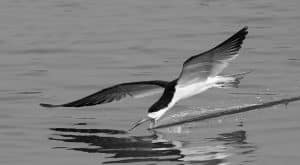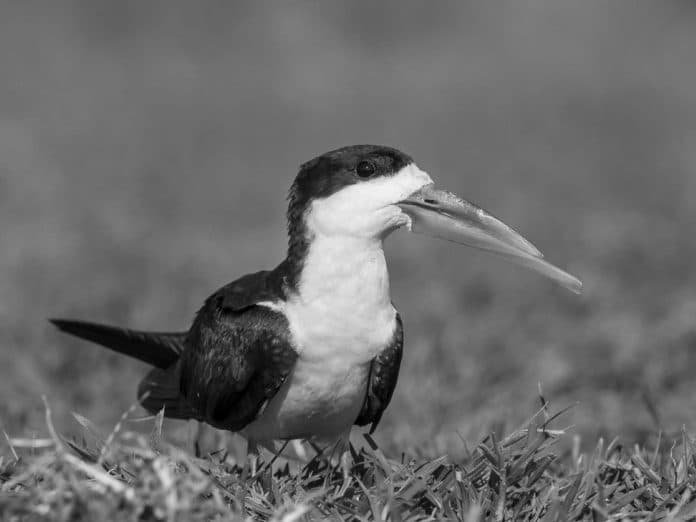Introduction to the African Skimmer in Tanzania
The African Skimmer, scientifically known as Rynchops flavirostris, is a fascinating bird species that can be found in the beautiful country of Tanzania. Tanzania, located in East Africa, is renowned for its diverse wildlife and stunning landscapes, making it a perfect habitat for this unique bird. The African Skimmer in Tanzania is known for its graceful flight and distinctive hunting technique, which involves skimming its lower beak through the water’s surface to catch small fish. In this article, we will delve into the habitat, physical features, feeding habits, breeding behavior, conservation status, and best locations to spot this remarkable bird in Tanzania.
Habitat and Distribution of the African Skimmer

The African Skimmer can be found in various parts of Tanzania, particularly in the Serengeti National Park and the surrounding areas. This bird species is primarily associated with freshwater habitats, such as rivers, lakes, and wetlands. It prefers open areas with sandbars or exposed beaches where it can establish its nesting colonies. The Serengeti, with its numerous rivers and vast grasslands, provides an ideal environment for the African Skimmer to thrive.
Physical Features and Unique Characteristics of the African Skimmer
The African Skimmer is a medium-sized bird with a distinctive appearance. It has a slim body, long pointed wings, and a deeply forked tail. Its most striking feature is its beak, which is long and thin, with the lower mandible extending beyond the upper mandible. This unique adaptation allows the skimmer to skim the water’s surface while flying, enabling it to catch fish with precision. The African Skimmer has a black cap, white underparts, and a reddish-brown back. During flight, its wings appear black on the upper surface and white on the under surface, creating a striking contrast.
Feeding Habits and Hunting Techniques of the African Skimmer
The feeding habits of the African Skimmer are fascinating to observe. Unlike most birds, it is predominantly crepuscular, meaning it is most active during the early morning and late afternoon. During these times, the skimmer takes to the skies and glides gracefully above the water, scanning for potential prey. Once it spots a fish near the water’s surface, it swiftly descends towards it, skimming its lower beak through the water. The sensitive lower mandible detects the fish’s movements and snaps shut, securing a meal for the skimmer. This unique hunting technique sets the African Skimmer apart from other birds and showcases its remarkable adaptability.
Breeding Behavior and Nesting Habits of the African Skimmer

Breeding season for the African Skimmer typically occurs during the dry months in Tanzania, which are from June to November. During this time, the skimmers form large colonies on sandbars or exposed beaches along the rivers. They construct shallow scrapes in the sand, which serve as their nests. The female skimmer lays two to three eggs, which both parents take turns incubating. Once the eggs hatch, the chicks are fed regurgitated fish by their parents. The African Skimmer’s breeding behavior and nesting habits highlight its strong social bonds and cooperative nature.
Conservation Status and Threats Faced by the African Skimmer
The African Skimmer is currently classified as a near-threatened species by the International Union for Conservation of Nature (IUCN). One of the main threats to its population is habitat loss and degradation due to human activities, such as dam construction and sand mining. Pollution of rivers and wetlands also poses a significant risk to the skimmer’s survival, as it relies on clean water bodies for its feeding and breeding. Additionally, disturbance caused by recreational activities and predation by introduced species further contribute to the decline of the African Skimmer’s population. Efforts are being made to protect its habitat and raise awareness about the importance of conservation.
Best Time and Locations to Spot the African Skimmer in Tanzania
If you are eager to catch a glimpse of the African Skimmer in Tanzania, the best time to visit is during the dry season from June to November. During this period, the water levels of rivers and lakes decrease, exposing sandbars and beaches where the skimmers establish their nesting colonies. The Serengeti National Park and its surrounding areas, such as the Grumeti River and Lake Natron, are prime locations to spot these remarkable birds. It is advisable to hire a local guide who is knowledgeable about the skimmer’s behavior and can assist in locating their nesting sites.
Tips for Observing and Photographing the African Skimmer

Observing and photographing the African Skimmer can be a rewarding experience. To increase your chances of spotting these birds, it is recommended to bring binoculars or a telephoto lens for your camera. Patience is key when observing skimmers, as they can be elusive and easily disturbed. It is important to maintain a respectful distance and avoid making sudden movements or loud noises that could startle them. Additionally, wearing neutral-colored clothing and blending in with the surroundings can help minimize their awareness of your presence. Remember to prioritize the well-being of the skimmers and their habitat by adhering to ethical wildlife viewing practices.
Other Bird Species Found in the Same Habitat as the African Skimmer
The habitat of the African Skimmer is home to a diverse array of bird species. While on your quest to spot skimmers, you may also encounter other fascinating birds such as the African Fish Eagle, Pied Kingfisher, Marabou Stork, and various species of herons and egrets. These birds share the same freshwater habitats and contribute to the overall richness of Tanzania’s avian biodiversity. Take the time to appreciate and learn about these remarkable feathered creatures that grace the skies and waters of Tanzania.
Conclusion: Appreciating the Beauty and Importance of the African Skimmer in Tanzania
The African Skimmer is a remarkable bird species that adds to the natural beauty and ecological importance of Tanzania. Its unique physical features, hunting technique, and breeding behavior make it a captivating subject for observation and study. However, the skimmer’s population is facing threats due to habitat loss and human activities. By raising awareness, supporting conservation efforts, and practicing responsible wildlife viewing, we can help protect this extraordinary bird and ensure its presence in the rivers of the Serengeti for future generations to admire and appreciate. So, pack your binoculars, visit Tanzania, and embark on an unforgettable journey to witness the grace of the African Skimmer in person.

































